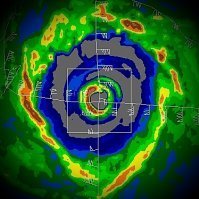-
Posts
4,715 -
Joined
-
Last visited
Content Type
Profiles
Blogs
Forums
American Weather
Media Demo
Store
Gallery
Everything posted by Windspeed
-
Despite its fast motion, 99L appears to be organizing the past few hours. There is curved banding in the south and east envelope with convection. Near the center of the broad circulation, convective pulsing is percolating. This should help tighten a vorticity maximum and TD15 should get classifed soon thereafter by this evening. I think this does develop and makes landfall as a named storm. It is hauling through. If it can develop by this evening, it will have a shot at hurricane intensity prior to landfall, otherwise it may run out of time.
-
Seriously, if something significant does advance west out if the MDR, that has ECONUS landfall written all over it.
-
That pattern tho..
-
It's actually performed better at TCG than the current operational. Yes, every once in a while a storm will form in the mid-range due to a feature in the pattern change. However, the current operationals are missing the mark too frequently on near-term TCG potential. Like 99L for example. The current para is the only one that has a TC. Perhaps that fails to occur and it misses the mark. But the operationals have chosen poorly with genesis environmental fields. We shall see.
-
I left off the '1'. Spring 2021 is tentative for upgrade if there are no issues.
-
Incorrect. That is the non-operational parallel GFS model that would become the GFS version 16 operational in 2021 if there are no hitches. It is still in experimental phase. The current operational GFS is version 15.
-
99L in the eastern Caribbean is looking really healthy today. It is convectively active along the axis with notable southerly backside flow in the low levels. This probably does not yet have a closed circulation at the surface, but the cloud pattern is suggestive for mid level cyclonic turning. There is a building upper 200 hPa anticyclone over the Caribbean and sufficient easterly 800 hPa moisture surge surrounding 99L's envelope. Shear is nil through its potential westward track. If the disturbance manages to close off a surface vortex, it has the ingredients to intensify.
-
It's absolutely possible but a rarer solution. You need a very strong NS/NF/Greenland maritime block and general troughness N. Plains and Central Canada. Takes a lot of luck (or bad luck depending on perspective) to get that setup and a TC in the right position, but it does occur. Anyone remember Hazel? Again, not saying this is going to happen, but SSTs off the SE are still way above normal. Isaias did little to upwell and the disturbance forecast to move ENE out into the Atlantic won't be strong enough to put much of a dent in the thermocline. Also similar setups have been Hugo and Isabel, though Isabel was a large mess by the time it got up to the Carolinas. You also need a favorable upper environment and mitigatable shear, which is also more difficult at that latitude. So it takes more than just the maritime block. But we can get NW moving systems off the SE to Outer banks and have them reach the Great Lakes region.
-
We've got an orange and two lemons now. ZCZC MIATWOAT ALL TTAA00 KNHC DDHHMM Tropical Weather Outlook NWS National Hurricane Center Miami FL 200 PM EDT Sat Aug 29 2020 For the North Atlantic...Caribbean Sea and the Gulf of Mexico: 1. A tropical wave located about 550 miles east of the Windward Islands is producing disorganized showers and thunderstorms. Some gradual development of this system is possible during the next several days while it moves westward at about 15 mph toward the Lesser Antilles. Regardless of development, this system will likely produce gusty winds and locally heavy rainfall across portions of the Windward and Leeward Islands on Sunday. * Formation chance through 48 hours...low...20 percent. * Formation chance through 5 days...low...30 percent. 2. Another tropical wave is located over the eastern Atlantic Ocean just southwest of the Cabo Verde Islands. This system is expected to move very slowly for the next several days, and some development is possible early next week over the eastern or central tropical Atlantic. * Formation chance through 48 hours...low...near 0 percent. * Formation chance through 5 days...medium...40 percent. 3. A low pressure area is expected to form off of the southeastern coast of the United States early next week. Additional subsequent development is possible as the system moves east-northeastward across the northwestern Atlantic Ocean. * Formation chance through 48 hours...low...near 0 percent. * Formation chance through 5 days...low...20 percent. Forecaster Beven
-
The only metric that seems off from seasonal forecasts at this point is accumulated cyclone energy (ACE). Though we're above normal, considering number of storms, an ACE of 42.1 seems low. However, bulk ACE generation is almost always in the months of September and more recently October when we experience a higher number of concurrent hurricanes. September hurricanes generally take tracks that allow them to last longer too, hence higher rate of ACE production.
-
13 named storms, 4 hurricanes, 1 major hurricane by August 26th...
-
The para is interesting in that it is building heights across the northern maritimes into a Canadian block by Sept 5th. That is a classic long-tracker pattern that typically results in repeating WATL landfalls. Also develops an Azores cutoff that breaks down 700 hPa flow off NW Africa and the MDR moistens with precipitable water substantially as we approach peak. This will have to be watched for pattern trends in coming runs as that would suggest a busy September.
-
The big three globals have been struggling with TCG since Dorian. No idea. A lack of data or some other nonsense. It is a known issue.
-
For those of us that enjoy recreational drugs...
-
Everything will be okay. All you need to do is just listen to Buckethead...
-
Lol Mike. You're afraid to use Josh's name? Dude has earned it.
-
I do not believe your eggdrop soup was hot enough to burn your tongue. Did you measure it with a thermometer? We need visual data of the thermometer or it didn't happen.
-
Hospitalized for alcohol poisoning.
-
Today I learned about hub clouds. Hub clouds... Hub clouds.............
-
Yes I am being narcissistic. Piss off.
-
If ever there was a case in point, this is it. 5+ days out you might peek at the operationals for patterns, precip, derived winds, feature locations, and especially entertainment purposes, but for estimates on TCs and their storm relative potential, you go with the different ensemble packages all night and day long. I don't mind beating that dead horse into a smear until frequent posters get it.
-
Possible Atlantic MDR development next week being modeled in several ensemble camps.






.png.754c6d7f65602780dbae1d3c4e86f31d.png)
